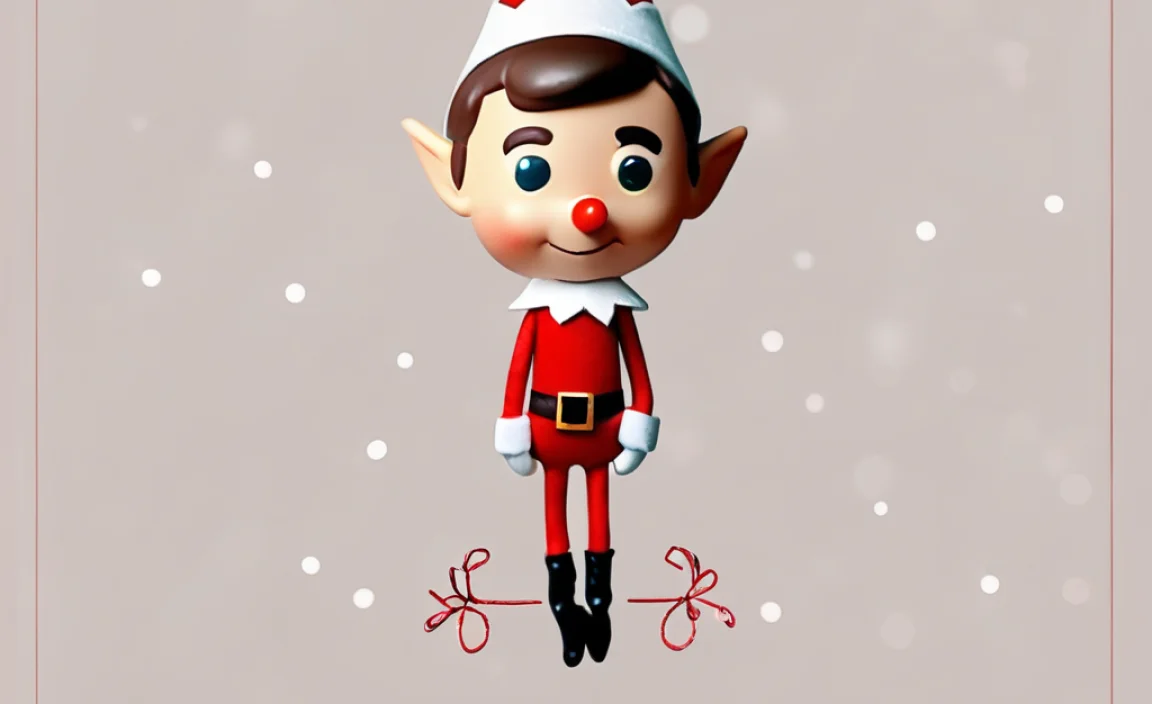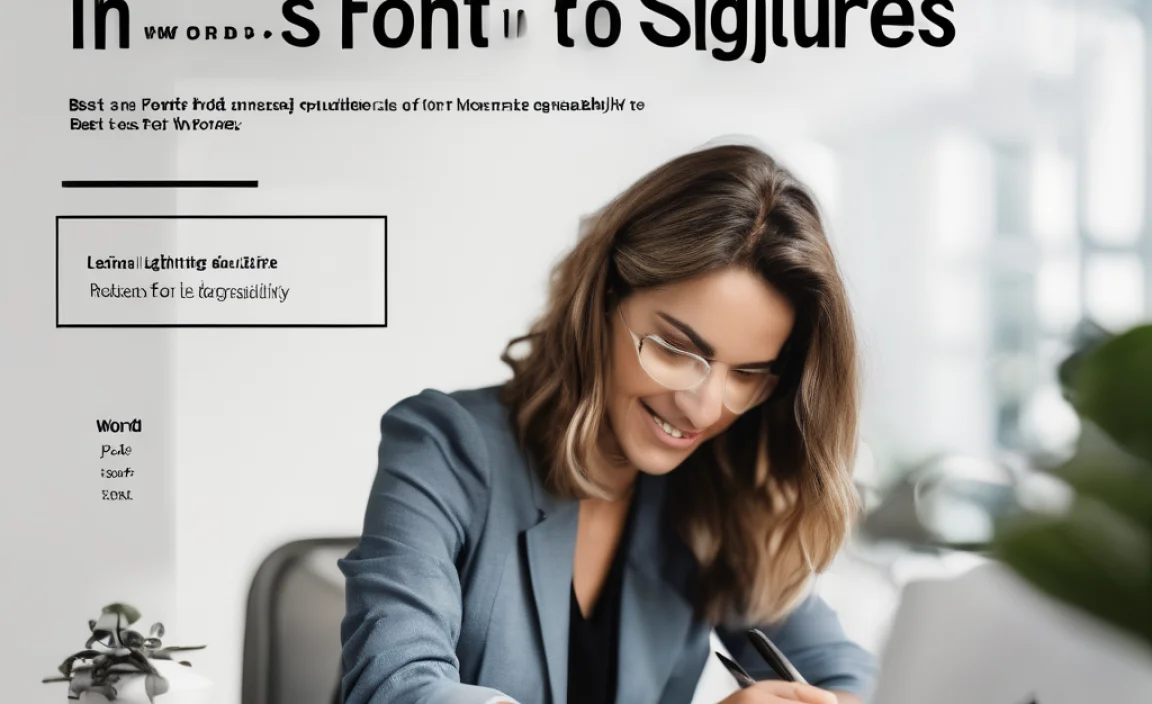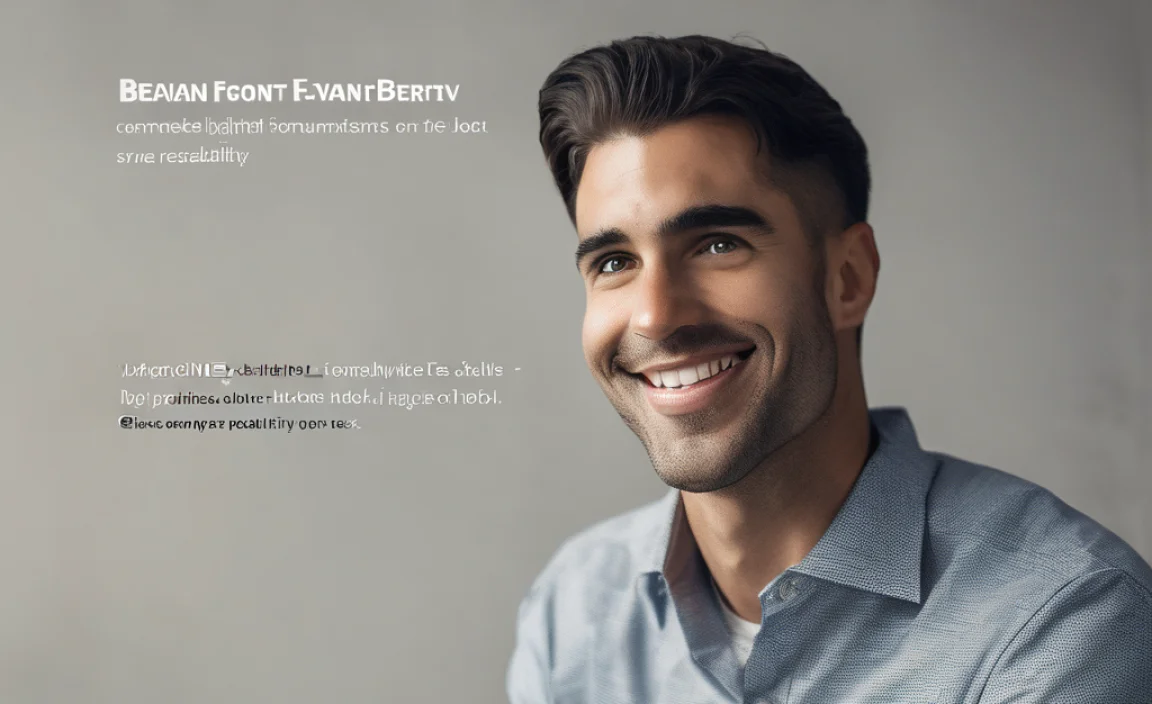Road Rage Font: Essential Quick Guide. Explore what makes a “Road Rage Font” striking, its common uses in design, and how to choose one that grabs attention without causing visual chaos. Learn to harness its power effectively for impactful branding and design projects.
Ever seen a sign or design that just screams urgency and boldness? You might be looking at what we affectionately call a “Road Rage Font.” These typefaces aren’t for quiet whispers; they’re designed to be seen, to grab attention, and to communicate a strong message, much like the urgent text on a highway sign. While the name sounds a bit intense, these fonts are fantastic design tools when used correctly. They can add serious punch to your projects, from bold headlines to eye-catching logos. Let’s dive into what makes them tick and how you can use them to make your designs unforgettable.
Understanding the “Road Rage Font” Vibe
So, what exactly is a “Road Rage Font”? It’s not an official typographic classification, but rather a descriptive term for fonts that possess certain characteristics. Think strong, impactful, and urgent. They often feature:
- Bold Weight: They are almost always heavy and thick.
- High Contrast: Sometimes, there’s a noticeable difference between thick and thin strokes, though this isn’t always the case.
- Clear Legibility: Despite their boldness, they need to be readable, even from a distance.
- Angular or Geometric Shapes: Many have sharp edges or clean, geometric forms.
- Sense of Urgency: They convey a feeling of importance and immediacy.
These fonts are inspired by the need for clear, quick communication in high-stress or fast-paced environments. The most common place you’ll see them is, well, on roads! Think of traffic signs, warning labels, and even emergency service vehicle lettering. The goal is to be seen and understood instantly, no matter the conditions.
Why Use a “Road Rage Font”?
Using a font that evokes this “road rage” feel can be incredibly effective for several design purposes. It’s all about creating impact and ensuring your message cuts through the noise.
- Grabbing Attention: In a crowded visual space, these fonts act like a powerful magnet, drawing the viewer’s eye directly to your text.
- Communicating Urgency: For sales, promotions, alarms, or important announcements, they can signal the importance and timeliness of the message.
- Establishing a Strong Brand Identity: If your brand is about power, speed, or resilience, this font style can be a perfect fit.
- Adding a Dramatic Flair: They can inject a sense of drama and excitement into designs that might otherwise feel flat.
- Improving Readability in Specific Contexts: For outdoor signage or digital displays where quick glances are the norm, their boldness can be a significant advantage.
Remember, the key is to use them strategically. Overuse can lead to designs that feel aggressive or overwhelming, much like actual road rage! But wielded wisely, they are powerful tools.
Types of Fonts That Embody the “Road Rage” Feel
While “Road Rage Font” isn’t a formal category, several common font classifications often exhibit these impactful qualities. Understanding these will help you identify and select the perfect typeface for your needs.
Heavy Sans-Serif Fonts
Sans-serif fonts, meaning they lack the decorative “feet” (serifs) at the ends of strokes, are often the go-to for this style. When they come in an extra-bold or black weight, they naturally convey strength and directness. Many geometric or grotesque sans-serifs fit this bill perfectly.
- Characteristics: Clean lines, uniform stroke width (often), excellent legibility.
- Where they shine: Headlines, call-to-action buttons, logos, signage.
- Examples: Impact, Arial Black, Oswald (Bold/ExtraBold), Anton, Bebas Neue (boldest weights).
Slab Serif Fonts (Heavy Variants)
Slab serifs have thick, block-like serifs. When these serifs and the main strokes are equally robust, the font becomes incredibly sturdy and impactful. These feel grounded, strong, and unafraid.
- Characteristics: Strong, blocky serifs, often with a monolinear or low-contrast feel.
- Where they shine: Strong headlines, posters, brand identities needing a robust feel.
- Examples: Rockwell Extra Bold, Arvo (Bold/Black), Roboto Slab (Black).
Display Fonts with Bold Qualities
Display fonts are designed for impact at large sizes. Many display fonts incorporate extreme boldness, sharp angles, or condensed forms to command attention, perfectly fitting the “road rage” aesthetic when needed.
- Characteristics: Highly stylized, designed for headlines, can be condensed or expanded, often feature unique elements.
- Where they shine: Event posters, album covers, strong branding elements.
- Examples: League Gothic, ChunkFive, Bangers.
Key Characteristics to Look For
When you’re searching for that perfect font to convey impact and urgency, keep an eye out for these specific design elements. They are the hallmarks of a typeface that can deliver a powerful visual punch.
Thickness and Weight: This is paramount. Look exclusively at the heaviest weights available – Black, Heavy, UltraBold, or slogans like “Extra Bold.” A thin or standard weight will not achieve the desired impact.
Stroke Contrast: While not always present, a deliberate contrast between thick and thin strokes can add a dynamic, almost aggressive feel. However, many effective “road rage” fonts have minimal contrast for ultimate clarity and solidity.
Letterform Shape: Angular terminals (the end of a stroke) or sharp corners can contribute to a more aggressive look. Conversely, very uniform, geometric shapes can also convey a sense of unyielding strength.
Width and Spacing: Condensed widths can create a feeling of packed energy and urgency, like text squeezed into a small space. Generous letter spacing can sometimes make even bold letters feel more open and commanding, while tight spacing can feel intense.
Overall Impact: Does the font feel strong? Does it command your attention immediately? Trust your instincts. These fonts are designed to make a statement.
How to Choose the Right “Road Rage Font”
Selecting the perfect font is a mix of understanding the aesthetics and considering the practical application. Here’s a systematic way to approach it:
1. Define Your Message and Purpose
What are you trying to communicate? Is it pure urgency, unwavering strength, or thrilling excitement? The context is everything. A font that works for a loud concert poster might be too much for a brand’s primary logo.
2. Consider the Application
- Digital vs. Print: Screen readability can differ. Heavy fonts can sometimes “fill in” at small sizes on screens.
- Size: These fonts often excel at large display sizes but might become overwhelming or unreadable when very small.
- Environment: Will it be seen from afar (like a billboard) or up close (like a website button)?
3. Assess Readability
This is crucial. Even the boldest fonts must be legible. Test the font at your intended size. Are the letterforms distinct? Is there enough breathing room between characters and words?
4. Think About Your Brand’s Personality
Does this font align with your overall brand image? If you’re a luxury brand, a harsh, aggressive font might clash. If you’re a performance gear company, it could be a perfect fit.
5. Test Pairings
You rarely use just one font. How will your chosen bold font pair with a secondary font? Often, a clean, lighter sans-serif or a simple serif can provide excellent contrast and balance, allowing the “road rage” font to shine without dominating the entire design.
Best Use Cases for “Road Rage” Style Fonts
Harnessing the power of these bold fonts means knowing where they fit best. Here are some prime examples:
- Advertising & Sales: For announcements like “SALE,” “LIMITED TIME,” or “NEW ARRIVAL” where you need immediate attention.
- Call-to-Action Buttons: On websites and apps, a bold font can make buttons like “SIGN UP,” “BUY NOW,” or “GET STARTED” impossible to miss.
- Headlines & Titles: For articles, posters, or flyers that need a strong, impactful opening statement.
- Event Promotion: Especially for high-energy events like concerts, sports games, or festivals.
- Warning Labels & Safety Signage: Where clarity and immediate recognition are critical, mimicking their original highway inspiration.
- Sports Branding: For team names, slogans, and athletic apparel where a sense of power and aggression is desired.
- Gaming & Entertainment: To convey excitement, challenge, or a bold narrative.
Font “Road Rage” Examples and Their Applications
Let’s look at a few fonts that often get this bold, impactful treatment and how they might be used. Keep in mind that many fonts come in various weights, so you’re typically looking for their heaviest options.
| Font Name | Description & “Road Rage” Qualities | Best Use Cases |
|---|---|---|
| Impact | Extremely condensed, heavy weight. Designed for headlines that need maximum density and punch. Feels very direct and commanding. | Poster headlines, bold subheadings, urgent notices. |
| Arial Black | A universally recognized, very heavy sans-serif. Simple, robust, and unmistakable. Creates a solid, unyielding presence. | General bold statements, website banners, signage. |
| Oswald (Bold/ExtraBold) | A sans-serif inspired by the classic alternate gothic typefaces. It’s versatile, condensed, and highly legible even at its boldest weights. | Web headlines, branding, marketing materials, short impactful phrases. |
| Anton | A display sans-serif designed for tightly set headlines. Very condensed and bold, offering strong visual impact. Excellent for short, powerful words. | Extreme headlines, logos, sporty branding. |
| Bebas Neue (all caps, bold) | Originally designed for headlines and posters, it’s a popular, free sans-serif. Its all-caps nature and generous proportions at bold weights make it stand out. | Blog post titles, advertising, social media graphics. |
| Roboto Slab (Black) | A modern slab serif with a balanced feel. The Black weight is incredibly strong, offering a solid, dependable, yet eye-catching appearance. | Strong subheadings, book titles, packaging design needing a sturdy feel. |
Tips for Effective Usage
Using bold, attention-grabbing fonts comes with its own set of best practices to ensure your design is impactful, not awful.
- Less is More: Reserve these fonts for critical elements like main headlines or key phrases.
- Contrast is Key: Pair a bold font with a lighter, more legible font (like a simple sans-serif or serif) to create visual hierarchy and prevent fatigue.
- Mind the Space: Ensure adequate letter spacing (kerning) and word spacing (tracking) so that heavy letters don’t feel too squashed, especially at large sizes.
- Consider the Background: Heavy fonts have a lot of visual weight. Make sure the background doesn’t fight with them.
- Hierarchy is Your Friend: Use size, color, and placement in conjunction with font choice to guide the viewer’s eye logically through your content.
- Test, Test, Test: Preview your design at different sizes and on different devices. What looks good on your screen might not translate perfectly everywhere.
External Resources for Font Inspiration
When you’re deep in the font selection process, sometimes a little external inspiration can go a long way. The world of typography is vast and beautiful!
- Google Fonts: A fantastic, free resource for discovering and testing a wide array of fonts. You can filter by weight and style to find bold options. Visit Google Fonts to explore.
- The Futurists: A History of Avant-Garde Design: For a deeper understanding of how bold typography has been used historically to make strong statements, exploring avant-garde movements can be insightful. (Note: This is a conceptual link for inspiration on impactful design history, as a direct, single URL can be tricky for broad historical topics unless it’s a specific archive or museum page).
- Design Blogs & Magazines: Websites like 99designs Blog and Canva’s design resources often feature articles on typography trends, font pairings, and case studies, showcasing how bold fonts are used effectively.
Frequently Asked Questions (FAQ)
What is the most common use for a “Road Rage” font?
The most common use is for urgent headlines, sales promotions, call-to-action buttons, and safety signage. Anything that requires immediate attention and clear communication.
Are “Road Rage” fonts always sans-serif?
Not exclusively, but heavy sans-serifs are very common because they are inherently clear and bold. Heavy slab serifs and some display fonts can also embody this impactful style.
Can I use a “Road Rage” font for body text?
Generally, no. These fonts are designed for impact at large sizes. Using them for body text, which is read in smaller blocks, would likely make the content difficult and tiring to read.
How do I avoid making my design look too aggressive with these fonts?
Balance is key. Pair the bold font with a lighter, more neutral typeface, use them sparingly for only the most important elements, and ensure there’s ample white space. Soften the overall aesthetic with complementary colors and imagery.
Where can I find free “Road Rage” style fonts?
Platforms like Google Fonts offer many bold, condensed, and heavy sans-serifs that fit the bill. Look for weights like “Black,” “Extra Bold,” or “Heavy.” Popular free options include Oswald, Anton, Bebas Neue, and Impact.
Is “Road Rage Font” a real typographic term?
No, “Road Rage Font” is an informal descriptive term used by designers to categorize fonts that are exceptionally bold, condensed, and attention-grabbing, often drawing inspiration from highway signage and other urgent communication mediums.
Conclusion
The “Road Rage Font,” while an unofficial term, perfectly captures a category of typefaces designed for maximum impact. These fonts, characterized by their extreme boldness, condensed forms, and commanding presence, are invaluable tools for designers looking to grab attention and convey urgency. By understanding their strengths and limitations, and by choosing them strategically for headlines, calls-to-action, and impactful branding elements, you can harness their power effectively. Always remember to prioritize readability and balance your bold choices with subtler designs to create compelling visuals that speak volumes without shouting unnecessarily. So go ahead, experiment with these powerful typefaces, and make your designs impossible to ignore!








